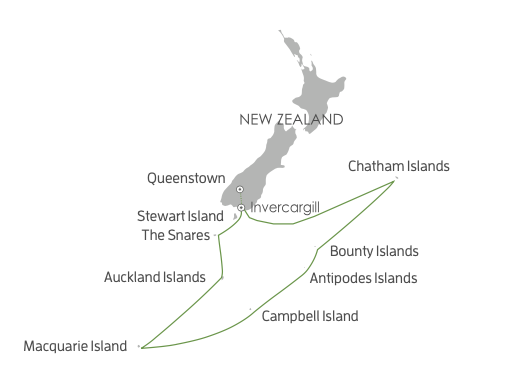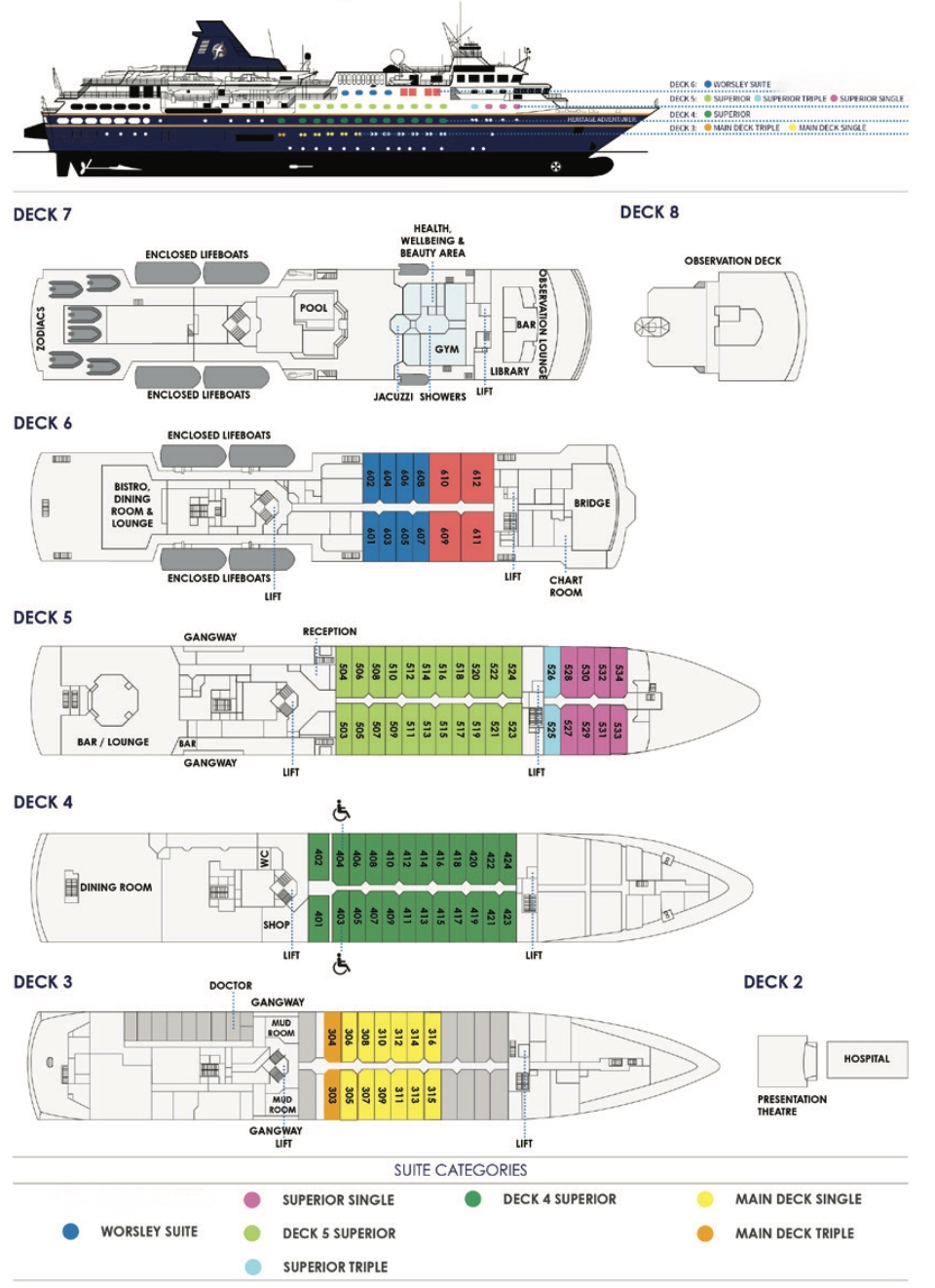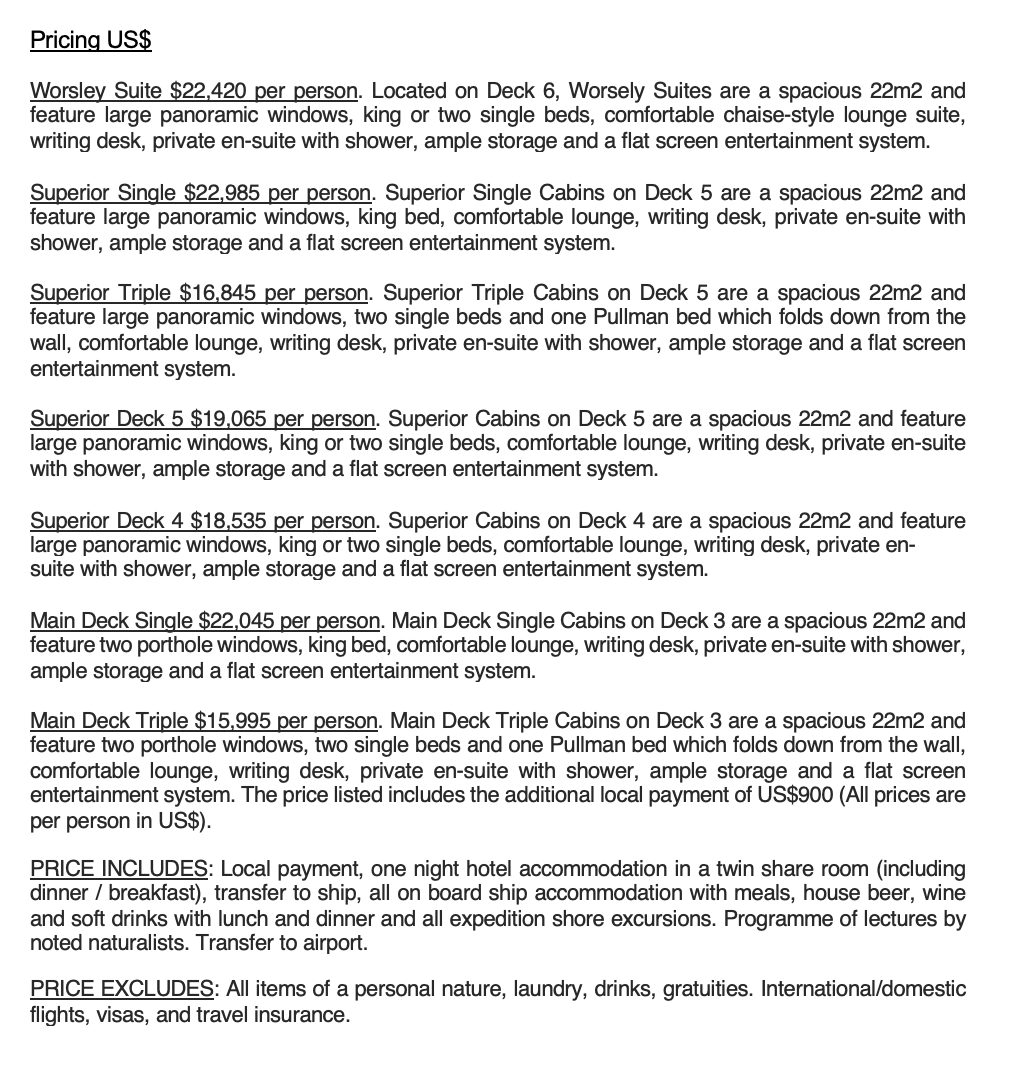Listen to the names: Snares, Bounty, Antipodes, Auckland, Campbell, Macquarie and Chatham Islands. They are music to the ears of 'Bird Photographers'. Apart from the Chathams, these islands are probably more isolated now than they were when they were discovered in the late 1700s and early 1800s and were regularly visited by sealers, whalers and government steamers searching for castaway sailors. While it is relatively simple to get to the Chatham Islands, opportunities to visit the 其他的鸟类 are rare. This expedition, as featured in Condé Nast Traveler's influential 'The 25 Best Places to Go in 2025' list, is the only one to include all of these islands. The islands occupy the tempestuous latitudes of the Roaring Forties and the Furious Fifties, but they are also known as the Albatross Latitudes and with good reason. Ten of the world's albatross 鸟类 breed in the region: five of them nowhere else but here. In fact, this zone, where the air is never still, hosts the most diverse collection of seabirds in the world. More than 40 鸟类 breed here which is at least 11 per cent of the entire world's seabird 鸟类. With the exception of the Chathams, the islands are all designated UNESCO World Heritage sites and are afforded the highest conservation status and protection by the Australian and New Zealand governments, so passage to their shores is not granted lightly. There are also islands that we visit within the Chatham Islands' Archipelago with similar status and protection. This expedition has huge appeal to pelagic enthusiasts, seabird photographers and those interested in island 特有鸟类. Though you don't have to be a keen birder to enjoy this voyage, people interested in islands and island ecology, botany, geology and an increasing number of photographers have enjoyed this trip immensely, as have those interested in the history of 南部 ocean discovery and exploration. Bird-Photo-Tours ASIA is the specialist in bird photography throughout Asia and Oceania and this subantarctic cruise provides quite literally a once-in-a-lifetime adventure photographing albatrosses, petrels, penguins and many other seabirds in one of the most outstanding locations in Oceania.


Albatrosses (12-鸟类): Black-browed / Buller's / Campbell's / Chatham / Grey-headed / Light-mantled / Northern Royal / Salvin's / Shy / 南部 Royal / Wandering / White-capped Albatrosses
Penguins (7-鸟类): Erect-crested / Gentoo / King / Rockhopper / Royal / Snares / Yellow-eyed Penguins
Petrels (13-鸟类): Cape / Chatham / Cook's / Common Diving / Great-winged / Magenta / Mottled / Northern Giant / Soft-plumaged / 南部 Giant / Westland / White-chinned / White-headed Petrels
Prions (4-鸟类): Antarctic Prion / Broad-billed Prion / Fairy Prion / Fulmar Prion
Shearwaters (4-鸟类): Buller's Shearwater / Flesh-footed Shearwater / Little Shearwater / Sooty Shearwater
Storm-petrels (4-鸟类): Black-bellied / Grey-backed / White-faced / Wilson's Storm-petrels
导游费/地面交通/住宿/膳食/入场费/司机、船夫、酒店和餐厅工作人员的小费。
国际航班 / 签证费 / 旅行保险 / 当地导游小费 / 酒类 / 洗衣 / 个人物品
Days 1-17 Subantartic cruise [16N, 15D, 30S].
Day 1: Queenstown, New Zealand. Guests should make their way to the designated hotel where we will spend the first night of the expedition. This evening there will be an informal get-together at the hotel for dinner: an excellent opportunity to meet fellow adventurers on your voyage and some of our Expedition Team.
Day 2: Port of Bluff, New Zealand. Today we enjoy breakfast in the hotel restaurant and have the morning free to explore Queenstown before returning to the hotel for lunch and departing for the Port of Bluff to embark on our subantarctic cruise. You will have time to settle into your stateroom or suite and familiarise yourself with the ship. You are invited to join the expedition team in the Observation Lounge and up on the Observation Deck as we set our course to The Snares and our adventure begins.
Day 3: The Snares, New Zealand. The closest Subantarctic Islands to New Zealand, they were appropriately called The Snares as they were once considered a hazard for sailing ships. Uninhabited, they enjoy the highest protection as Nature Reserves. It is claimed by some that these islands are home to more nesting seabirds than all of the British Isles together. We plan to arrive early in the morning and as landings are not permitted we will Zodiac cruise along the sheltered 东部 side of the main island if weather conditions are suitable. [摄影目标: Snares Penguin, Snares Island Tomtit, Sooty Shearwater, New Zealand Fernbird].
Day 4: Auckland Islands, New Zealand. The Auckland Islands group was formed by two volcanoes which erupted some 10-25 million years ago. They have subsequently been eroded and dissected by glaciation creating the archipelago as we know it today. Enderby Island is one of the most beautiful islands in this group and is named after the distinguished shipping family. This northern most island in the archipelago is an outstanding wildlife and birding location and is relatively easy to land on and walk around. The island was cleared of all introduced pests in 1994 and both birds and the vegetation, especially the herbaceous plants, are recovering both in numbers and diversity. Our plan is to land at Sandy Bay, one of three breeding areas in the Auckland Islands for the Hooker's or New Zealand Sea Lion, a rare member of the seal family. Beachmaster bulls gather on the beach defending their harems and mating with the cows shortly after they have given birth to a single pup. During our day ashore there will be several options, some longer walks, some shorter walks and time to enjoy the wildlife. The walking is relatively easy, a board walk traverses the island to the dramatic 西部 cliffs from there we follow the coast on the circumnavigation of the island. [Photographic Highlights: 南部 Royal Albatross, Northern Giant Petrel, Auckland Island Shag, Auckland IslandFlightless Teal, Auckland Island Banded Dotterel, Auckland Island Tomtit, Bellbird, Pipit, Red-crowned Parakeet, Yellow-eyedPenguin, Light-mantled Sooty Albatross and Subantarctic Snipe].
Day 5: At Sea. As we make our way south through the Furious Fifties also known as the Albatross latitudes, the birding especially south of the Auckland Islands should be good. We will have a series of presentations on the biology and history of the Subantarctic Islands. We will also prepare you for our visit to Macquarie Island. [摄影目标: Wandering Albatross, Royal Albatross, Black-browed Albatross, Light-mantled Sooty Albatross, Salvin's Albatross, Grey-headedAlbatross, Northern Giant Petrel, 南部 Giant Petrel, Sooty Shearwater, Little Shearwater, Fairy Prion, Fulmar Prion and Antarctic Prion, Soft-plumaged Petrel, Mottled Petrel, White-headed Petrel, White-chinned Petrel, Grey-backed Storm-petrel, Wilson's Storm-petrel and Black-bellied Storm-petrel].
Days 6 - 7. Macquarie Island, Australia. The great Australian Antarctic Explorer Sir Douglas Mawson once called Macquarie Island "One of the wonder spots of the world". You are about to discover why as we spend two days exploring this amazing Island. It was one of the first of the Subantarctic Islands to obtain World Heritage Status and that was largely due to its unique geology. It is one of the few places on Earth where mid-ocean crustal rocks are exposed at the surface due to the collision of the Australian and Pacific Plates. The island was discovered in 1810 and was soon ravaged by sealers who introduced various animals including rats, cats and rabbits. The native bird population was virtually eliminated and plants destroyed. The Tasmania Parks and Wildlife Service embarked on a very ambitious eradication program. The island is now predator free and both the birds and plants are responding. It is amazing to witness the regeneration and the increase in the number of birds. Macquarie Island is home to four 鸟类 of penguin, Kings, Royals, Gentoo and Rockhopper. The Royal Penguin occurs nowhere else in the world. During our visit we will land at two sites (subject of course to weather and sea conditions) and you will get a chance to see, observe and photograph all four 鸟类, although the Rockhopper is much harder to capture than the 其他的鸟类. Macquarie also has a large population of 南部 Elephant Seals. Pups are born in October and weaned in November when the breeding adults return to sea. The weaners and sub-adults lie around on the beaches. The weaners go to sea sometime in January, running the gauntlet of Orcas or Killer Whales who are waiting offshore. We plan a landing at the Australian Antarctic Research Base at Buckles Bay where we hope to meet with scientists and base staff. The original base was established in 1947 and the island has been 'manned' since then. It is one of the longest continuously occupied bases in the Subantarctic. [摄影目标: King Penguin, Royal Penguin, Gentoo Penguin, Rockhopper Penguin, 南部 Elephant Seals].
Day 8: At Sea. At sea en route to Campbell Island there's time to unwind after the adventures of Macquarie Island. Look forcetaceans and albatross, join a lecture or catch up on your photos and journalling.
Day 9: Campbell Island, New Zealand. Today we explore Campbell Island, New Zealand's 南部most Subantarctic territory. Its history is as rich and varied as the other islands we have visited. Discovered in 1810 (by the same sealing captain who discovered Macquarie Island) it too was soon occupied by sealers who introduced rats and cats which have since been eradicated. The vegetation which the great English botanist, Sir Joseph Hooker described in 1841 as having a "Flora display second to none outside the tropics" is now flourishing and is nothing short of spectacular. A number of options here will enable you to explore via extended walks towards Northwest Bay and an easier walk to the Col Lyall Saddle. All of these options allow you the opportunity and time to enjoy the 南部 Royal Albatross which nest here in large numbers. We also visit areas of the island which contain outstanding examples of the megaherbs for which the island is renowned. [摄影目标: 南部 Royal Albatross, Campbell Albatross, Campbell Teal, Campbell Shag, Subantarctic Snipe, Light-mantled Sooty Albatross, Northern Giant Petrel, 南部 Skua, Red-billed Gull, Black-backed Gull, Antarctic tern, Redpoll, Dunnock and New Zealand Pipit].
Day 10: At Sea. At sea en route to the Antipodes, it is a day for pelagic birding. [摄影目标: Wandering Albatross, 南部 Royal Albatross, Campbell Albatross, Light-mantled Sooty Albatross, Salvin's Albatross, Grey-headed Albatross,Northern Giant Petrel, 南部 Giant Petrel, Sooty Shearwater, Little Shearwater, Fairy Prion, Fulmar Prion, Antarctic Prion, Soft-plumaged Petrel, Mottled Petrel, White-headed Petrel, White-chinned Petrel, Grey-backed Storm-Petrel, Wilson's Storm-petrel, Black-bellied Storm-petrel and the Common Diving-petrel].
Day 11: Antipodes Islands, New Zealand. The Antipodes group of islands is the most isolated and perhaps the least known of New Zealand's Subantarctic Islands. Sealers lived here in the decades immediately after their discovery in 1806. The islands are of volcanic origin, but are heavily eroded especially the 西部 shoreline. The largest of the group is Antipodes Island. Landings are not permitted so we plan to cruise along the coastline by Zodiac. [摄影目标: Antipodes Parakeet, Reischek's Parakeet, New Zealand Pipit, Erect-crested Penguin and Rockhopper Penguin].
Day 12: Bounty Islands, New Zealand. We arrive at the incongruously named Bounty Islands, the remote northernmost of the five New Zealand Subantarctic groups. They were discovered by Captain Bligh just months before the infamous mutiny. Here inhospitable granite knobs, tips of the submerged Bounty Platform, are lashed by the 南部 Ocean. They are home to thousands of Salvin's Albatross, Erect-crested Penguins, Fulmar Prions and the endemic Bounty Island Shag – the world's rarest. We plan to arrive in the early morning and if conditions are suitable we will cruise by Zodiac around the granite outposts to take a closer look at the birds which breed there. New Zealand Fur Seals which were almost hunted to extinction in the Subantarctic Islands are present in large numbers. [摄影目标: Salvin's Albatross, Erect-crested Penguin, Fulmar Prion, Bounty Island Shag].
Day 13: Chatham Islands, New Zealand. As we continue toward the Chatham Archipelago, there are excellent opportunities for pelagic birding today. In particular, we will look out for the Chatham Island Petrel which has been seen on this leg of the voyage before. In the past we have observed the very rare Chatham Island Taiko in this area. Endemic to theChatham Islands, the Chatham Island Taiko – also known as the Magenta Petrel – is among New Zealand's most endangered鸟类. It is one of the world's rarest seabirds with a population estimated to number less than 150. This morning we will cruise around spectacular Pyramid Rock, a basalt outcrop south of Pitt Island. This is the only breeding place of the Chatham Island Albatross. During the afternoon we arrive at South East Island. This has to be one of the world's greatest nature reserves and landings are not permitted. However, we should obtain good views of the very rare New Zealand Shore Plover and Chatham Island Oystercatcher from the Zodiacs as we cruise along the coast. We should also see the Pitt Island Shag which nests on the island. This evening we cruise back along the south coast, this is where the only known population of theTaiko breeds and also where they are attempting to establish a new population of the Chatham Island Petrel in a predator free area. We have seen both Taiko and Chatham Island Petrel in this area on previous expeditions. [摄影目标: Chatham Petrel, Magenta Petrel, Chatham Albratross, New Zealand Plover, Chatham Oystercatcher, Pitt Shag].
Day 14: Chatham Islands, New Zealand. The Chatham Archipelago consists of one large island and numerous smaller islands and rocky islets. Only two of the islands are inhabited. They represent New Zealand's 东部 most territory. The islands were originally settled by East Polynesians. In the 1400s the population became isolated and interestingly developed its own distinct culture. The islands were discovered by Europeans in the 1790s. Sealers and settlers followed and then in the 1830s Māori from New Zealand invaded killing and enslaving many of the indigenous people. The impact of the original settlers, the Europeans and later the Māori people on the native flora and fauna was disastrous. Introduced animals, hunting, fires and land clearing wiped out many 鸟类 of endemic birds. Fortunately a number survived on the offshore islands in the archipelago.With a new generation has come a new awareness and a willingness to be part of a concerted conservation effort. A number of private reserves have been established, a lot of replanting has taken place and predators are being controlled. Today we will visit one of the original private reserves established by a local family on the south coast of the main island where there is a very good chance to see the endemic Chatham Island Pigeon and Warbler. The pigeon was close to extinction until recently,and is now in good numbers. The road takes us through developed farmland where we will undoubtedly see numerousintroduced 鸟类 and possibly the Weka. Near our landing in Waitangi there is a good chance of seeing the endemic Chatham Island Shag. [摄影目标: Chatham Pigeon, Chatham Gerygone, Chatham Shag].
Days 15 - 16: At Sea. En route to Bluff we will cross the Chatham Rise, a large, relatively shallowly submerged part of the Zealandia continent that stretches east from near the South Island of New Zealand. Nutrient-rich waters from the south mix with warm northern waters and there is an overlap between northern pelagic 鸟类 and birds from 南部 latitudes, so we can expect great pelagic sightings. [摄影目标: Wandering Albatross, Royal Albatross, Black-browed Albatross, White-capped Albatross, Salvin's Albatross, Northern Giant Petrel, Cape Petrel, Westland Black Petrel, White-chinned Petrel, Great-winged Petrel, Grey-backed Storm-petrel, White- faced Storm-petrel, the Diving- petrel, Cook's Petrel, Flesh-footedShearwater, Buller's Shearwater, Sooty Shearwater and Little Shearwater, Fairy Prion, Broad-billed Prion].
Day 17: Invercargill / Queenstown, New Zealand. Early this morning we will arrive in the Port of Bluff. After a final breakfast and completing customs formalities we bid farewell to our fellow voyagers and take a complimentary coach transfer to either Invercargill or Queenstown Airports. In case of unexpected delays due to weather and/or port operations we suggest you not to book any onward travel until after midday from Invercargill and after 3pm from Queenstown.
[关键词: N: 晚上 / D: 全天 / S: 半天]



诸葛民在亚洲生活了超过 15 年,期间在整个亚洲大陆进行了超过 125 次鸟类摄影之旅,从西部的哈萨克斯坦,穿过印度和中国,到东部的日本,以及从堪察加半岛海岸线北至印度尼西亚。仅在中国,诸葛民就以肖像质量标准拍摄了 1,200 多种中国鸟类,足迹遍及中国所有省份以及大多数与中国接壤的国家。这些鸟类摄影之旅的长度从几天到几个月不等,其中包括对中国新疆自治区进行为期三个月的鸟类摄影考察,很可能成为过去十年来该地区旅行次数最多的外国人。诸葛民还进行了为期四个月的鸟类摄影徒步穿越喜马拉雅山脉,从西部的印度拉达克和克什米尔,进入喜马拉雅山的不丹王国,然后到达印度的西孟加拉邦和锡金,最后到达阿鲁纳恰尔邦以及喜马拉雅山脉东部的阿萨姆邦。诸葛民的照片曾在众多媒体渠道发表,包括英国广播公司 (BBC) 和中国国有媒体、各种鸟类杂志和期刊,包括东方鸟类俱乐部的 BirdingASIA。他拥有自己的中国鸟类网站 www.BirdingInChina.com,他的书《中国鸟类肖像》将于 2026 年出版。此外,诸葛民还在亚洲和欧洲展示了拍摄鸟类的电影,他的鸟类照片在亚洲国内外的许多社交媒体平台上发布,并主持了许多鸟类摄影讲座和步行活动,特别是针对儿童。因此,诸葛民在亚洲大陆拍摄鸟类方面积累了丰富的经验,这些专业知识为建立亚洲鸟类摄影之旅奠定了基础,该旅行由鸟类摄影师为鸟类摄影师设计。
(i) 宾馆均靠近鸟类摄影地点 (ii) 步行速度较轻 (iii) 徒步或攀爬。 (iv) 所有地点均不在境内高度 (v) 没有露营地。